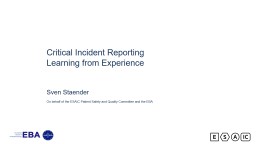

Learning from Experience Sven Staender On behalf of the ESAIC Patient Safety and Quality Committee and the EBA Outline Development of the critical incident technique Definition Practical aspects of implementation ID: 1026413
Download Presentation The PPT/PDF document "Critical Incident Reporting" is the property of its rightful owner. Permission is granted to download and print the materials on this web site for personal, non-commercial use only, and to display it on your personal computer provided you do not modify the materials and that you retain all copyright notices contained in the materials. By downloading content from our website, you accept the terms of this agreement.
1. Critical Incident Reporting Learning from ExperienceSven StaenderOn behalf of the ESAIC Patient Safety and Quality Committee and the EBA
2. OutlineDevelopment of the critical incident techniqueDefinitionPractical aspects of implementationAnalysis of critical incidents
3. Complication conferences Post-hoc chart review Direct Observation in units Incident Reporting/5Various Methods for Safety Analysis
4. High number of eventsLow number of eventsVery low number of eventsNo eventsClassical epidemiological toolsHigh statistical powerLocal studiesReporting systemsNational or international studiesRisk and accident modellingFMEAIncidence1 : 101 : 1001 : 1‘0001 : 10‘0001 : 100‘0001 : 1 Mio1 : 10 MioVarious Methods for Safety Analysis
5. Development of Incident reporting Personnel Psychol., 1951, 4, 373-381Psychol. Bulletin, 1954, 4, 327-358
6. http://asrs.arc.nasa.gov/Aviation Safety Reporting System
7.
8. Critical Incident Reporting SystemInt J Med Inform. 1997 Nov;47(1-2):87-90.
9. What are critical incidents exactly ?
10. SHELL - ModelSoftwareHardwareEnvironmentLifeware / LifewareEdwards, E. Man and Machine: Systems for Safety. 21-36. 1972. London, UK, British Airlines Pilots Association.
11. Recoveries ?(creative, activ)Near missAccident,ComplicationNormal stateYesYesNoNoDefences ?(instituted, passiv)Algorithmen, SOP‘s, Technique ...Critical IncidentOrganisation, Rules(Software)Technique(Hardware)Patient(Environment)Human, Team, Communication(Lifeware)Error Danger. SituationNon-Routine-OperationsZ Arztl Fortbild Qualitatssich. 2001 Jul;95(7):479-84
12. The “Heinrich” ratioHeinrich HW. Industrial Accident Prevention: A Scientific Approach. New York, London 1941129300Major injuryMinor injuryNo injury accidents
13. Examples
14. “Pattern recognition”Audtls can eisaly raed a txet eevn wehn olny the frist andlsat chracater of a wrod are in its cerorct psoition.Case 1
15. “Pattern recognition” Look-alike drugs:Case 1
16. Case 2 10-year old boy for minor urologic procedure I.v. Induction without problems LMA placement easy Difficulties with ventilation
17. Case 2 10-year old boy for minor urologic procedure I.v. Induction without problems LMA placement easy Difficulties with ventilation Removal of the LMA Chewing gum on the tip of the LMA
18. Children love chewing gum....
19. 4 year old child for hernial repair Uneventful general anaesthesia In RCR empty 20 cc syringe to “play” with The child is already fully awake and watches the RCR-nurse doing her job...Case 3
20. Case 2
21. CVC insertion planned Known allergy to iodine desinfectants Clear alcoholic desinfectant chosen and inserted in one bowl Lidocain in the other bowlCase 4
22. Case 4
23. CVC insertion planned Known allergy to iodine desinfectants Clear alcoholic desinfectant chosen and inserted in one bowl Lidocain in the other bowl After the first few cc’s of “Lidocain” severe local pain ...Case 4
24. Case 4
25. Conditions for Incident Reporting Voluntary Anonymous / confidential No disciplinary action/ blame free Easy to use Feedback of information
26. Strengths of Incident Reporting Number compared with accidents Root causes Training and learning potential Recoveries Cost !!
27. Under reporting Bias No Risk-Controlling tool AnalysisWeaknesses of Incident Reporting
28. Analysing Critical Incidents
29. What does such an analysis of an incident datapool mean?Frequency of „Critical Incidents“Medication incident 30 %Technical event 10 %Communication event 20 %Organisational event 20 %Hygiene incidents 10 %Other 10 %Analysis of Critical Incidents
30. What do such numbers on a hospital level mean?Number of „Critical Incidents“ reported per yearHospital A 300Hospital B 20Hospital C 800Analysis of Critical Incidents
31. „Counting Incidents is a waste of time.“Charles BillingsFormer president of the Aeromedical Space Association
32. Learning through analysisSingle case analysisHow ?
33. Who is responsible ?
34. The user ?The technique ?The contractor ?The innocent bystander ?The Front-end operator ?
35. Which cases ?
36. Local Significancee.g. Quick AlertsPDCA - CycleCase CollectionRisk-LikelyhoodRatioStandard ProcessWhich Cases ?Single Cases !2. General Importance
37. Local Significancee.g. Quick AlertsPDCA - CycleCase CollectionRisk-LikelyhoodRatioStandard ProcessWhich Cases ?Single Cases !2. General Importance
38. Improvement cycle acc. PDCA (Plan – Do – Check – Act)
39. Local Significancee.g. Quick AlertsPDCA - CycleCase CollectionRisk-LikelyhoodRatioStandard ProcessWhich Cases ?Single Cases !2. General Importance
40. Case clustering
41. What is reported more than once ?What is the most important ?What is least accepted by patients / public ?What is most easily fixed ?Case clustering
42. Local Significancee.g. Quick AlertsPDCA - CycleCase CollectionRisk-LikelyhoodRatioStandard ProcessWhich Cases ?Single Cases !2. General Importance
43. Drug prescribedTransfer Prescription to Patient ChartsTake drug out of stockLocal PharmacyDelivering to WardDistributeto StockPrepare DrugPlan for correct PatientAdministerDrugStandard Process
44. Drug prescribedTransfer Prescription to Patient ChartsTake drug out of stockLocal PharmacyDelivering to WardDistributeto StockPrepare DrugPlan for correct PatientAdministerDrug0034002700180064Standard Process
45. Local Significancee.g. Quick AlertsPDCA - CycleCase CollectionRisk-LikelyhoodRatioStandard ProcessWhich Cases ?Single Cases !2. General Importance
46. Recommendations ouf of Single Cases
47. One single case can lead to significant change !
48. How to analyse ?
49. Multiprofessional teams (nursing staff & doctors& technicians etc.)No simple answersCollect a few main causesFollow each main-cause by asking ‚5 x WHY‘Analysis
50. The „Swiss Cheese Model“Reason J. 1993
51. StructureTechniqueCommuni-cationTeamIndividualProcessacc. ReasonThe system approach
52. BarriersError forcing conditions
53. acc. ReasonStructureTechniqueCommuni-cationTeamIndividualProcessThe system approach
54. StructureTechniqueCommuni-cationTeamIndividualProcessThe system approachacc. Reason
55. StructureTechniqueCommuni-cationTeamIndividualProcessacc. ReasonThe system approach
56. StructureTechniqueCommuni-cationTeamIndividualProcess
57. Incidents and Near Misses are a free lesson !
58. “Stop trembling !! Just explain what happened”
59. Thank you for your attention.For further informations feel free to visit the ESAIC Patient Safety website or contact thechairman of the Patient safety and Quality Committeepatient.safety@esaic.org https://www.esaic.org/patient-safety/